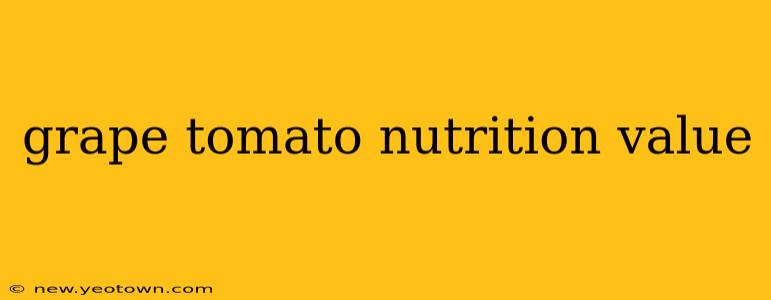Imagine biting into a juicy, sweet grape tomato, bursting with flavor. But beyond its delightful taste lies a surprising nutritional punch. These miniature fruits, often overlooked, pack a significant amount of vitamins, minerals, and antioxidants, making them a valuable addition to any healthy diet. Let's delve into the world of grape tomato nutrition, exploring their benefits and answering some frequently asked questions.
What are the nutritional benefits of grape tomatoes?
Grape tomatoes, despite their small size, are nutritional powerhouses. They're low in calories but rich in essential vitamins and minerals. A single serving (about 1 cup) provides a good source of Vitamin C, an antioxidant crucial for immune function and collagen production. They also offer a decent amount of Vitamin K, important for blood clotting and bone health. Furthermore, they contain potassium, a vital electrolyte for maintaining healthy blood pressure. The lycopene content is particularly noteworthy, a potent antioxidant linked to reduced risk of certain cancers and heart disease. This makes them a delicious and healthy snack or addition to salads, pasta dishes, or sandwiches.
How many calories are in grape tomatoes?
One cup of grape tomatoes contains roughly 27 calories. This makes them a fantastic low-calorie option for those watching their weight, allowing you to enjoy a flavorful snack or ingredient without significantly impacting your daily calorie intake. Their low-calorie, high-nutrient profile makes them a smart choice for weight management.
Are grape tomatoes good for weight loss?
Their low calorie count and high fiber content contribute to their weight-loss-friendly profile. The fiber helps you feel fuller for longer, reducing overall calorie consumption. They're also hydrating, which can aid in weight management efforts. While not a magic bullet for weight loss, incorporating grape tomatoes into a balanced diet and exercise regimen can be beneficial.
What are the health benefits of eating grape tomatoes?
The health benefits extend beyond weight management. The abundance of antioxidants, particularly lycopene, is a key player. Lycopene has been associated with a decreased risk of several chronic diseases, including certain cancers and heart disease. The vitamins and minerals contribute to overall health and well-being, supporting immune function, bone health, and blood pressure regulation.
Are cherry tomatoes and grape tomatoes the same?
While often used interchangeably, there is a subtle difference. Cherry tomatoes tend to be slightly larger and rounder than grape tomatoes, which are typically smaller and more oblong. However, nutritionally, they are very similar, both boasting high levels of vitamins, minerals, and antioxidants.
How to incorporate more grape tomatoes into your diet?
The versatility of grape tomatoes makes incorporating them into your diet easy and enjoyable. Add them to salads for a burst of flavor and color. Roast them with other vegetables for a delicious side dish. Use them as a topping for pizzas or pasta dishes. They also make a refreshing and healthy snack on their own, or added to skewers with other vegetables and grilled. The possibilities are endless!
Conclusion: The Unsung Hero of the Produce Aisle
Grape tomatoes often get overlooked, but they deserve a place in the spotlight. These tiny fruits offer a significant nutritional punch, providing essential vitamins, minerals, and powerful antioxidants. Their low calorie count and high fiber content make them a beneficial addition to any weight-management plan. So next time you're at the grocery store, reach for a pint of these little gems and savor their deliciousness while enjoying their remarkable health benefits. Their versatility and nutritional profile make them a true unsung hero of the produce aisle.

